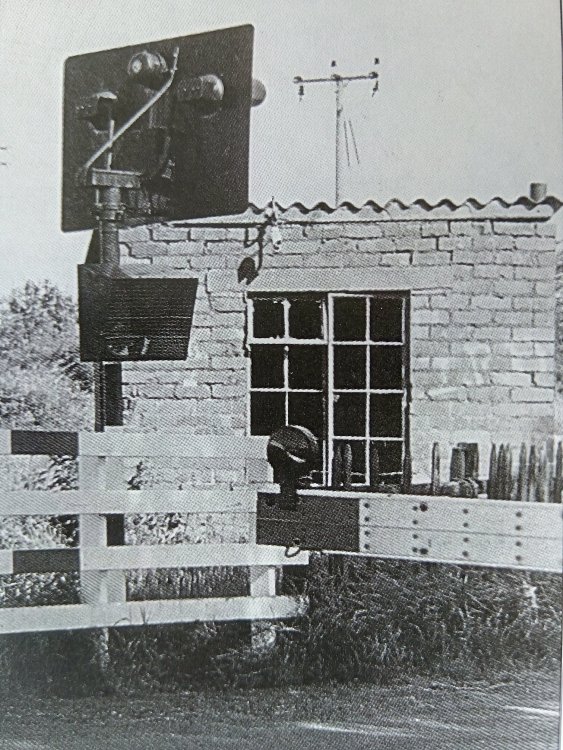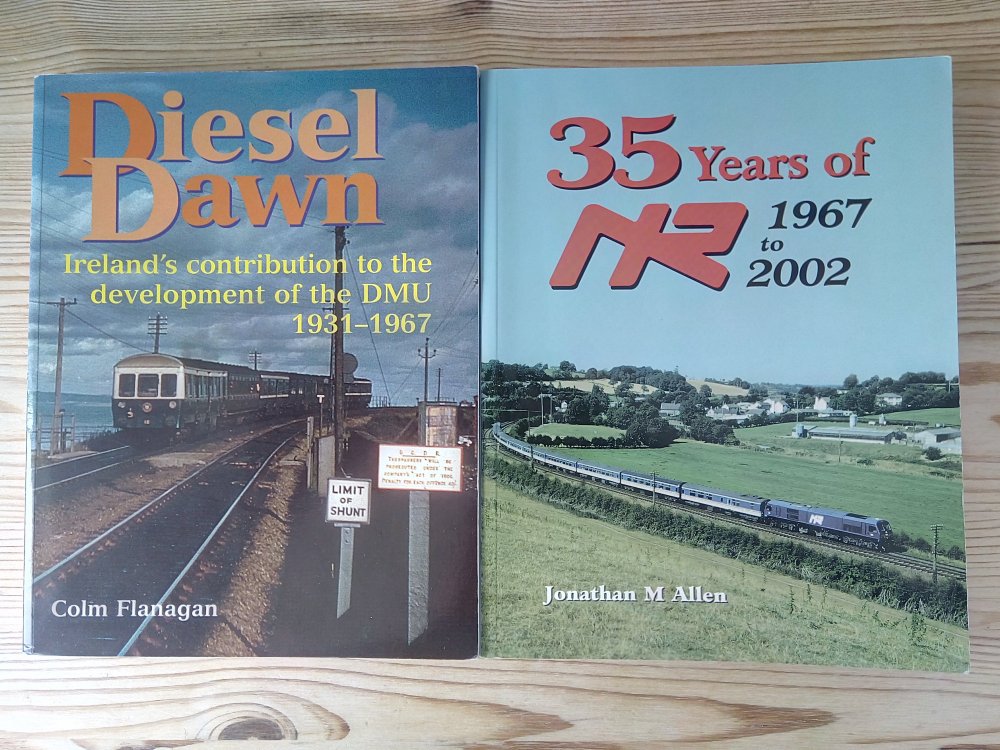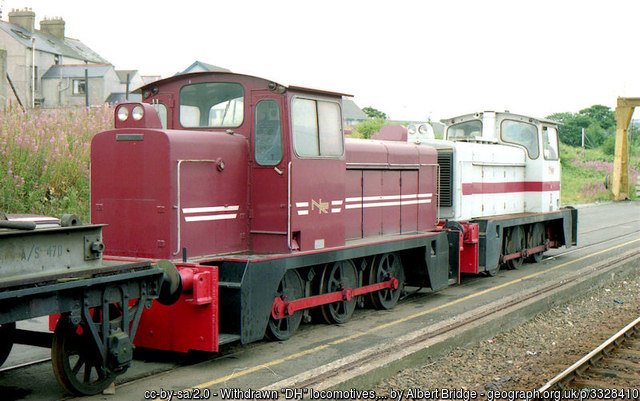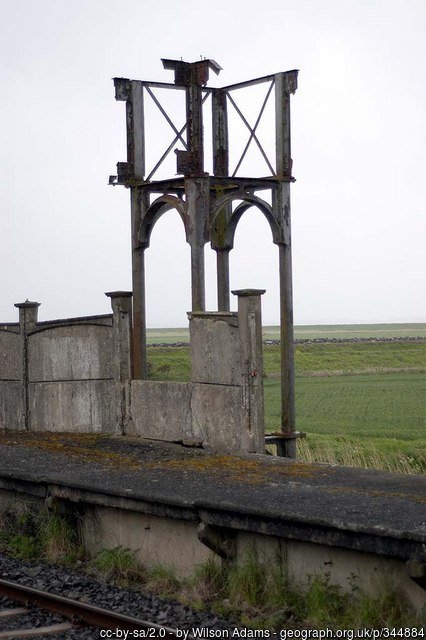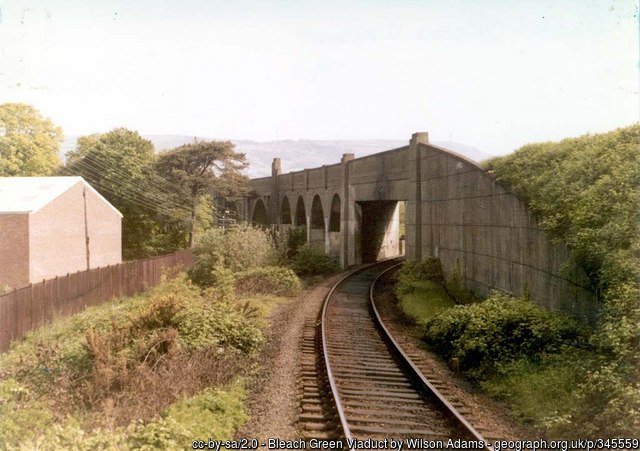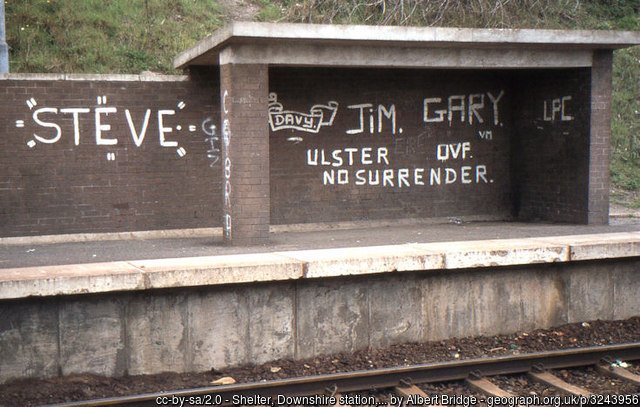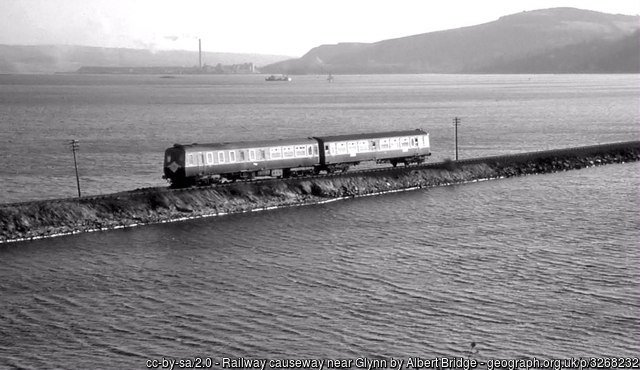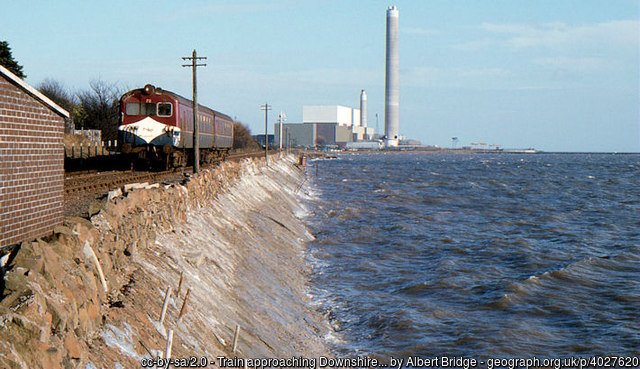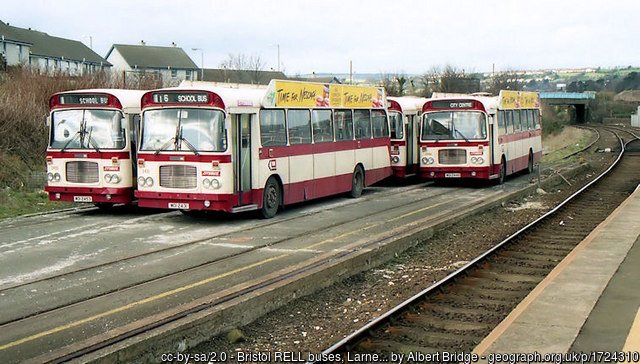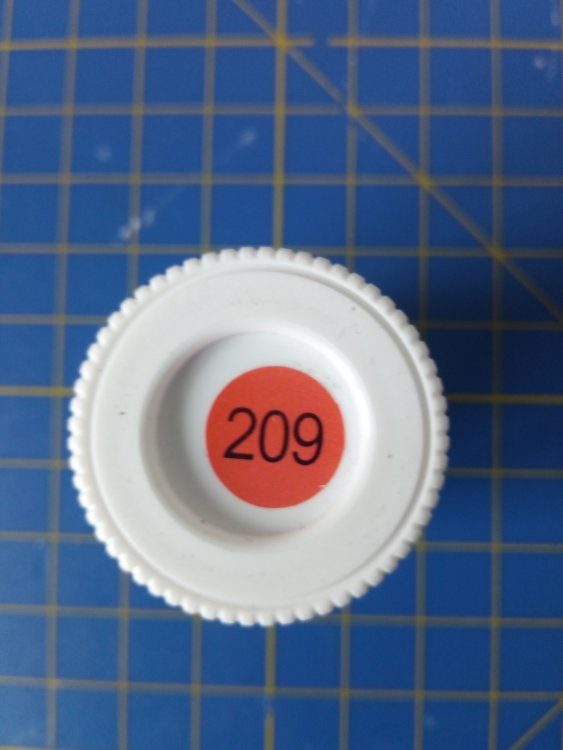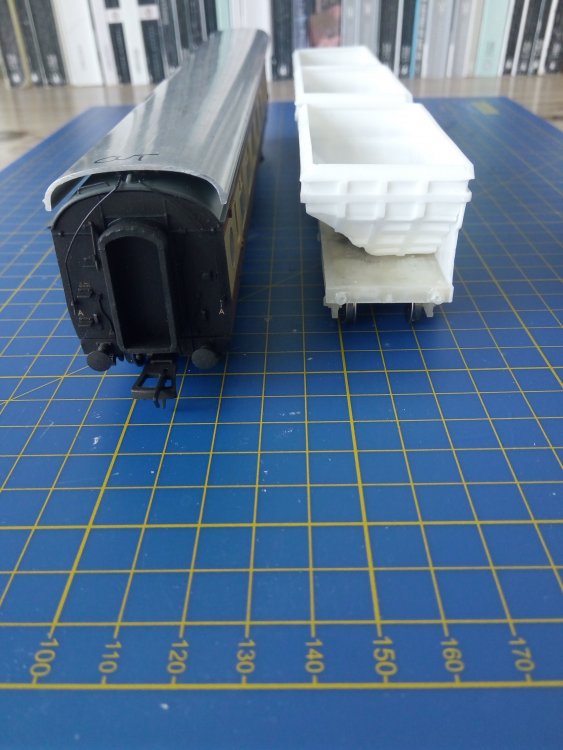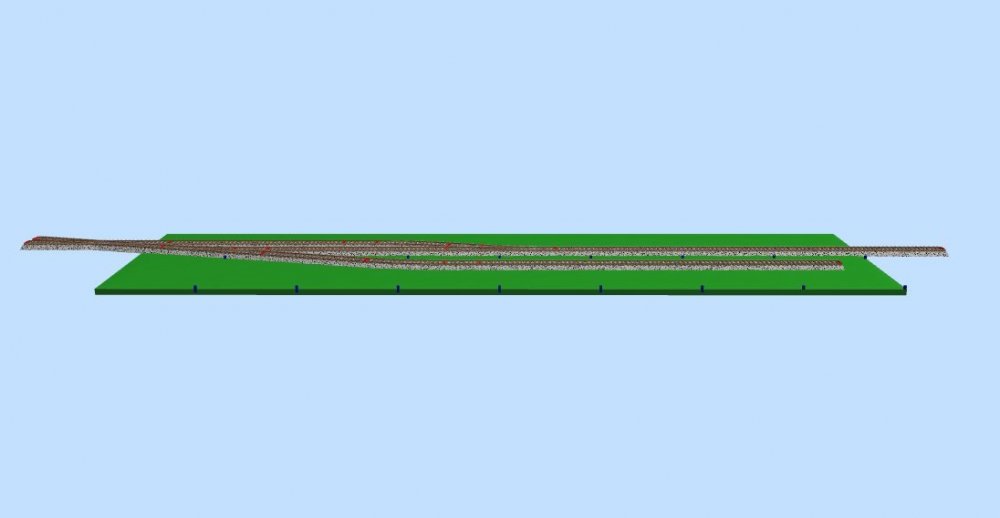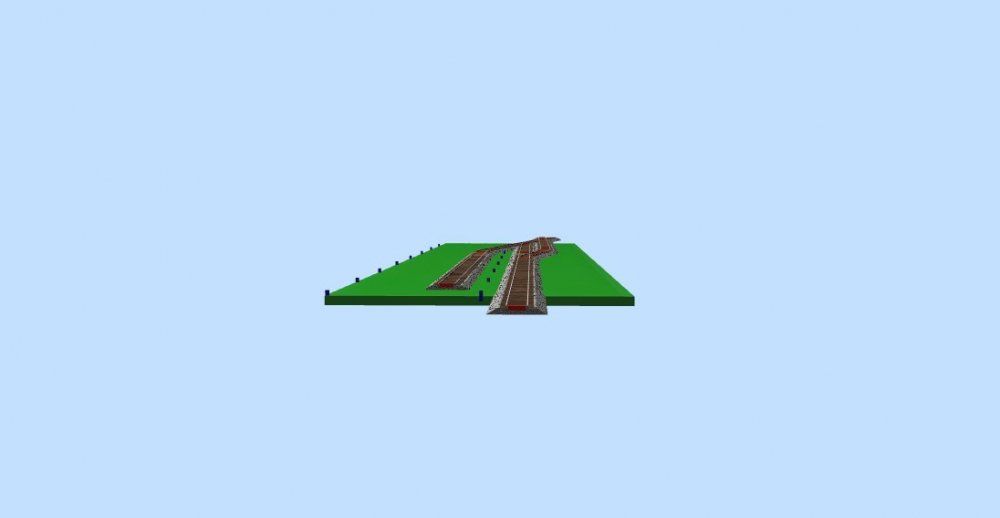
NIR
Members-
Posts
373 -
Joined
-
Last visited
Content Type
Profiles
Forums
Events
Gallery
Blogs
Store
Community Map
Everything posted by NIR
-
Tuam station around 1969/70 when it was still open to passengers, walked through to the platforms with my mother and saw something like a C Class running. Dún Laoghaire Pier 1972, got off the ferry into a curved station and onto what I now think was an AEC push pull to Pearse (or Westland Row as Dubliners still seemed to call it). Derry Foyle Road in 1972 when derelict, played inside with lots of rubble lying around and a rounded wooden kiosk or buffet or something just beyond the buffers. 1972 on the journey back to England, from Sligo to Dublin I can remember Moate but looking at the map I have no idea how that could have happened as we went past Connolly (Amiens Street) not into Heuston (which I never knew the old name of). I remember seeing the CIÉ 'flying snail' logo too, either in 1969/70 or 1972, or maybe both. Lisburn-Antrim late 70s/mid 80s plus I remember passing the overgrown triangle that led to Great Victoria Street, 'Rosser NF Skins' graffiti prominent across the wasteland. York Road station until mid 80s, older version and newer version.
-
Looks good, is this a kit and where do you get the grilles?
-
Of course no NIR (NCC) layout could be complete without one of these totally utilitarian lineside huts Single-skin brickwork, metal-framed windows and a corrugated pent roof - and such little architectural merit they actually have architectural merit. One of these seemed to be passed every couple of miles, I'm assuming they are for PW or maybe a ground frame, this one looks like it might have had telegraph wires* into it via the bracket above the window. This is heavily cropped from a Diesel Dawn/JM Allen photo, does anyone know of other photos? * and there's another detail to model, poles leaning this way and that
- 91 replies
-
- 1
-

-
- 1975
- mixed livery
-
(and 8 more)
Tagged with:
-
They would definitely be more interesting than a 1970s Mark 2 set. Those always seemed boringly BR to me and the Hunslets looked so much like a BR 'Western' too (though the photo of the blue Hunslet with white/blue stripe Mark 2s at Derry is giving me nostalgia now). My home ground would have been BR blue, urban, high/low level, electrified - I even heard someone being electrocuted - so I found the whole NIR experience fascinating.
- 91 replies
-
- 1
-

-
- 1975
- mixed livery
-
(and 8 more)
Tagged with:
-
I've had a look through the tables of stock inherited by NIR in 35 Years of NIR, noting stock that survived in use into the 1970s and the various ad-hoc conversions that took place, and there are certainly lots of oddities to model outside of the canonical builds of AEC, MED, BUT, MPD and 70 class 1 GNR coach to 1971 1 UTA MPD trailer (fitted 70 class) to 1973 9 NCC coaches to 1973/75 2 GNR general utility vans to 1976/77 2 UTA dual MED/MPD trailers to 1976/77 5 NCC full brake coaches to 1976/80 1 GNR BUT trailer (fitted/conv. 70 class trailer) 1969-80 1 NCC Railcar 1 and 4 trailer (conv. signals van) 1970-78(?) 1 UTA MED trailer ex-Ganz trailer (conv. van) 1973-77 2 GNR BUT trailers (conv. PW brake van) 1974-80(?) 2 GNR AEC power cars (conv. van) 1974-83(?) 9 GNR BUT power cars (conv. hauled) 1975-78 1 GNR BUT trailer (conv. hauled) 1975-78 then conv. PW brake van 1978-82(?) 4 UTA MED trailers (conv. van) 1975-85(?) 1 UTA MPD trailer (conv. 70 class trailer) 1976-86 2 UTA MPD power cars (conv. hauled) 1979-81 6 UTA MPD trailers (conv. hauled) 1979-81 (maybe 7 not 6?) So it looks like an eight to ten coach loco-hauled set of older stock was kept in various forms up until 1981 together with a succession of brakes and vans into the early/mid 1980s. From then onwards except for one twin cab MPD power car in use until 1983 it was just 70 Class, Mark 2 and 80 Class in operation, the 70 Class being inherited from the UTA and the last two being new builds by NIR. Unfortunately not much can be gleaned on the wagons inherited by NIR except for the following survivals and conversions: xx NCC brown vans to 1978 10 NCC parcels vans (conv. 4 wheel flat wagons) 1972-1980s 3 NCC coaches (conv. bogie flat wagons) 1974-1980s then some conv. PW use 1980s- No mention of brakevans, opens, etc
- 91 replies
-
- 2
-

-

-
- 1975
- mixed livery
-
(and 8 more)
Tagged with:
-
I think the generic term is a yard crane, Coles was a manufacturer of all sorts of cranes.
-
More essential reading The tables are invaluable - so much to model between 1975 and 1985, a long tail of remnants of this and that - and the photos confirm memories such as blue Hunslets at Derry. That's my budget for books used up.
- 91 replies
-
- 1975
- mixed livery
-
(and 8 more)
Tagged with:
-
Not seen too much on here about costs so here is a budget 250 Tools and books 500 Rolling stock 250 Basic layout So around £1000 to get things up and running with lots of NIR exotica such as 70s cut-down opens PW set, MED parcels van, ex-BUT power car loco-hauled coach and 80s spoil wagon PW set, then add around £200 to round things off with some ready-to-run CIE freight.
- 91 replies
-
- 1975
- mixed livery
-
(and 8 more)
Tagged with:
-
Being new to this I have never actually heard a few things said. I know that CIE is not 'cee' and NIR is not 'nerr' but how do you pronounce MED and BUT? I guess it is acronyms with a vowel that are the problem, so MPD is 'emm pee dee' and not 'mupud', or do some of these have extra vowels supplied? I'm all ears...
-
Silver Fox don't seem to be accepting orders so I have been thinking of a NIR DH 1 Class shunter to get me started. NIR had few locos but I do remember these at York Road, once again they were very distinctive and left an impression. The Hornby Sentinel is so infuriatingly near but yet so far it almost hurts. 4 not 6, sloped not squared, yet everything else seems so close... Too much to put right (and just how old is that flat wagon?)
- 91 replies
-
- 1975
- mixed livery
-
(and 8 more)
Tagged with:
-
Great, I was thinking of giving it a coat of Halfords red primer and taking it from there
- 14 replies
-
- 1
-

-
- ncc
- courtaulds
-
(and 1 more)
Tagged with:
-
- 91 replies
-
- 2
-

-
- 1975
- mixed livery
-
(and 8 more)
Tagged with:
-
There is a layout thread 'Bantry' that discusses this (page 3)
-
On forums you often hear people talk of their ultimate 'grail' or 'exit' item, the one thing that would draw a line under everything for them, complete fulfilment. Someday I would like to assemble an NIR MPD set, five or more cars (including two power cars) in mixed (but coexisting) liveries including a loco-hauled coach or two (maybe an ex-GNRI BUT power car conversion), all modelled finely and correctly even with no kit support, a painstaking labour of love over several years, maybe never finished. What is yours?
-
It's the English that's the translation! - so you need to back translate. I think it depends on what you want Kerry to mean, then whether the castle is of, in or from Kerry From Wikipedia Kerry (Irish: Ciarraí or more anciently Ciarraighe) means the "people of Ciar" which was the name of the pre-Gaelic tribe who lived in part of the present county. I'm not an Irish speaker but your version looks like it might not be inflected (the ending changed to mean of, in, from, etc) and the word order looks a bit Old Irish to me so I would put a na in the middle to make the relation clear Caisleán na Chiarraí 'Castle of the people of Ciar' I'm very open for corrections...
-
The Cambrian kits certainly look the part, and interesting that the wagons seemed to vary so much in reality. Looking at the photo I posted at the start the grey wagon on the right does look like it could have an extra plank, if not the extra height. An important wagon to give things an NCC/NIR feel I think, even into the late 70s.
- 14 replies
-
- ncc
- courtaulds
-
(and 1 more)
Tagged with:
-
Yes, it was hosted here already so I posted it, hope you don't mind. Maybe I'm getting a bit too fussy?
- 14 replies
-
- ncc
- courtaulds
-
(and 1 more)
Tagged with:
-
That looks fine to me, over here it would be bleached a powdery white but your local climate says differently!
-
Has there ever been a kit for the NCC Courtaulds open wagon? The ready-to-run Dapol A005 LMS 4 plank open is steel underframed while the Ratio 576 LMS 4 plank open kit is wooden underframed but looks just a bit too wrong at the ends. That seems to be it for LMS 4 plank opens, to which the NCC Courtaulds open was closely related. In their later cut down variant the NCC Courtaulds opens are as distinctively NIR as the UTA spoil wagons
- 14 replies
-
- ncc
- courtaulds
-
(and 1 more)
Tagged with:
-
Humbrol 209 Fire Orange (fluorescent, gloss) This looks a lot like the distinctively Irish 'warning red' I remember on signals, end flashes, etc. Was that on NIR too, or just CIE/IE? And since when? I'm not sure if I am remembering it from CIE or NIR or from 20 or 40 years ago Thanks
-
The Bleach Green segment from 01:00 has a very eerie science fiction quality to it
-
I did enjoy it though, would do it again.
- 91 replies
-
- 1975
- mixed livery
-
(and 8 more)
Tagged with:
-
Haha, maybe. I used a wooden rolling pin and rolled the profile while it rested on the modelling mat, always lengthwise from one end to the other with uniform pressure. Mainly along the centreline but sometimes angled off to one side or the other if the profile seemed to lose its symmetry. Nearly always on the topside but rolled a few times from the underside too (it left marks on the rolling pin!), always rolling a couple of times then measuring the spread along its length for uniformity. Rolled forty or fifty times in total. Best to roll before cutting to length as the rolling induces a slight bow upwards near the ends. http://www.dartcastings.co.uk/mjt/2970.php
- 91 replies
-
- 1975
- mixed livery
-
(and 8 more)
Tagged with:
-
Current actual progress... MED parcels van left, using a rolling pin to flatten the aluminium BR Mark 1 profile actually seems to have worked! The profile lost around 2mm in height and spread a millimetre or so uniformly along its length, not a problem as it is now an NIR prototypical 9 feet wide! The repeated rolling even produced a nice bodyshell ripple when looking along its length. Spoil wagons right, awaiting a true up in hot water then struts, brakes and buffers. I like these a lot!
- 91 replies
-
- 1975
- mixed livery
-
(and 8 more)
Tagged with:
-
Been playing around with some free software. I'm now thinking in terms of a 4x1 micro with through running - a single road sector plate completing the loop offscene to the left and a single road fiddle yard completing the main offscene to the right - the long sweep of siding to the front becoming central, conferring a more prototypical scale on the layout. Imagine the loop continuing left and a platform on the main continuing right for the same length as the siding and there is your prototype. In operation this means the passenger set and the freight set always have to cross each other on the layout, the freight set entering the loop from the left then getting run around and pulled fully back left onto the sector plate before being propelled into the siding and the passenger set now a full three coach railcar with the rightmost coach stopped in the fiddle yard. Very theatrical I'm sure, micro layouts seem to have a strange language all of their own. Just two points, wow, and look at all that space! These are small radius points but thanks to the sector plate (represented here by the crossover, imagine the crossover pivoting as a single track) the freight gets a straight run when propelled back into the siding, the backscene (curved in that corner) obscures any toy-like snaking of the passenger railcar entering/leaving on the main centre road and, with no reverse curve onto the sector plate, any snaking is minimised. A straight road from the main through points into a siding is a doubtful prototype but it does have some value here, and while the following looks more prototypical it does seem less 'modelgenic' somehow. Think of the micro as a compression of this prototype, the NCC having typically remodelled an up/down passing loop into an up/down main and loop. Just discovered the 3D view function! The layout does seem to have a very prototypical look about it at trackside despite (or maybe because of?) the straight lines. Maybe you don't actually need transition curves at micro level? Entering from the left this looks a fairly realistic throat, with lots of straight then curve. A home signal is assumed offscene on the near side at the point where the loop diverges, originally controlling entry to the left hand road of the loop but retained as a running signal on the main. A starting signal is assumed offscene on the far side, originally sited to control exit from the left hand road but re-sited onto the main beyond the platform during remodelling. Imagine a silo at the end of the siding obscuring the 'hole in the sky' to its left - think Magheramorne or Kilroot. Entering from the right the way ahead is clear with the platform on the right and a stop signal at its far end. No particular reason for it to be here, I just want an NCC somersault signal so it is here as the home signal originally controlling entry to the left hand road of the loop but retained as a running signal on the main. A starting signal is assumed offscene on the far side before the main re-converges with the loop, originally sited to control exit from the left hand road of the loop but retained as starting signal for freight leaving the siding (which itself prototypically trails from the former up/down loop, explaining the convoluted run around/pull back/propel forward way it is operated). The only sign that any of these assumed signals exist will be the correct number of signal wires disappearing offscene to an assumed signal cabin. Take the point rodding to an assumed token-released ground frame and no ground signals are required, leave the somersault signal set to clear and we can assume the signal cabin has been switched out, it's all sounding very NIR rationalisation in progress. Imagine a vanishing point between hills and sea to the left across a flat, watery expanse - think Limavady Junction. From the front the siding holds centre stage, the shortness of the loop causing an arriving freight to be prototypically dwarfed within the length of the siding. Imagine a low relief precast concrete overbridge set at an oblique angle with tightly splayed abutments obscuring the 'hole in the sky' to the left - think Bleach Green. A slight kink in the loop from the remodelling, a crude and angular entry to the siding... this plan has history.
- 91 replies
-
- 1975
- mixed livery
-
(and 8 more)
Tagged with:
.png.c363cdf5c3fb7955cd92a55eb6dbbae0.png)
